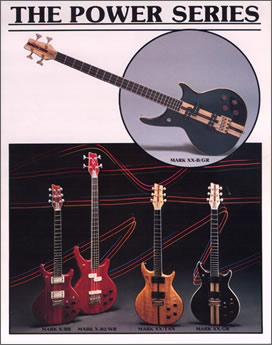 The Ibanez Musician was born out of the Japanese copy boom of the 1970s, which also helped spawn the Ibanez Destroyer and Iceman.
The Ibanez Musician was born out of the Japanese copy boom of the 1970s, which also helped spawn the Ibanez Destroyer and Iceman.
After Ibanez were sued for copying Gibson designs they branched out into original designs. Their first original models were the aforementioned two guitars, as well as the Performer, a Les Paul-type with a small curve cut into the bass side of the neck joint.This design has been more famously used by another Japanese company, Aria, on the iconic PE series.
Around 1978 the Performer was followed by the new Studio and Musician series.
The Musician was a more conservative piece of design than the wild stylings of the Iceman and the “Explorer-on-steroids†look utilised on the Destroyer.
It had a body shape halfway between a Stratocaster and a Les Paul, the same overall shape as a double cutaway PRS, although of course those guitars came about five years later. The most basic model was the MC100, with a bolt-on neck, although all the others, up to the custom order MC550WN model (of which only 465 were made), were neck-through.
The Studio series is less well-known, and less upscale than the Musicians. The Studio series all had set necks, although this was the only main difference to the Musician.
This new series of guitars were known for their excellent sustaining properties, although this did lead to extra unwanted weight. The woods used were usually walnut and maple (for the through-neck), plus ash or walnut “wings†which formed the actual body.
Pickups were Ibanez Super 88 humbuckers, and the high-end MC500 had an onboard three-band EQ activated by a toggle switch. This gave the player free rein to create a properly unique sound, for when the other two toggle switches activating phase reversal and coil splitting of the pickups just weren’t enough.
The MC500 had controls for the passive pickup mode, and three more knobs for when the EQ switch was on. The passive controls were a master volume, master tone, three-way pickup selector and the coil split and phase reversal switches. When the third toggle switch was activated the active controls (a different knob type to avoid confusion between the passive and active controls) controlled Bass boost, Midrange boost and Treble boost. The control layout for the Musician MC500, while vast, was quite simple and easy to use.
The EQ allowed for a vast spectrum of sounds, and the beautiful woods, through-neck, carved top and huge sustain made the MC500 one of the more desirable guitars of the late 1970s. There are also many good reviews of the other guitars in the series, and the models have a cult following among players.
The guitars aren’t too rare, but can be fairly hard to find sometimes. A recent search on eBay uprooted a few guitars, mostly in America.
An MC500 is going for just under £1100, while another MC200 looks to be going for significantly less.
Every review I have read of these guitars praises them, particularly the MC500, and they are worth quite a lot now.
Below is a picture of a beautiful MC500 (albeit with no strings attached), and I will attempt to explain the control layout.

![]()
![]()
![]() I thought you may be interested to see this.
A high end guitar collecting friend of mine has a guilty pleasure. Collecting Charvel Spectrums!
His addiction has been satisfied for the time being, with the arrival of a black model from Australia, although he is making noises about the lack of maple necked models.
He has also persuaded a few collecting friends of his to indulge too, and between them the Spectrum collection is now in double figures.
So what's all the fuss about?
The reason is, these are great guitars... versatile, with an extra tone eq pot and great for gigging with.
They have an 80's vibe about them (don't get too near that pointy headstock!), and the quality of the construction is undeniable.
I thought you may be interested to see this.
A high end guitar collecting friend of mine has a guilty pleasure. Collecting Charvel Spectrums!
His addiction has been satisfied for the time being, with the arrival of a black model from Australia, although he is making noises about the lack of maple necked models.
He has also persuaded a few collecting friends of his to indulge too, and between them the Spectrum collection is now in double figures.
So what's all the fuss about?
The reason is, these are great guitars... versatile, with an extra tone eq pot and great for gigging with.
They have an 80's vibe about them (don't get too near that pointy headstock!), and the quality of the construction is undeniable.

 The Ibanez Musician was born out of the Japanese copy boom of the 1970s, which also helped spawn the
The Ibanez Musician was born out of the Japanese copy boom of the 1970s, which also helped spawn the 
 One of the better known (and I use that term loosely) Daion models was the semi-solid ES-335-alike 555 Headhunter, which featured an innovative third cutaway on the bottom of the body.
One of the better known (and I use that term loosely) Daion models was the semi-solid ES-335-alike 555 Headhunter, which featured an innovative third cutaway on the bottom of the body.
 Ibanez received a cease- and-desist order and decided to make more original models. This culminated in the Iceman and Destroyer of the late 1970s. The Destroyer started in 1975 as a very impressive Gibson Explorer copy also called Model 2459, but was phased out around a year later.
Ibanez received a cease- and-desist order and decided to make more original models. This culminated in the Iceman and Destroyer of the late 1970s. The Destroyer started in 1975 as a very impressive Gibson Explorer copy also called Model 2459, but was phased out around a year later.